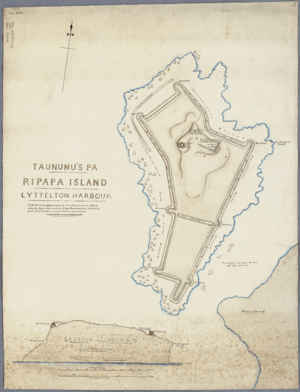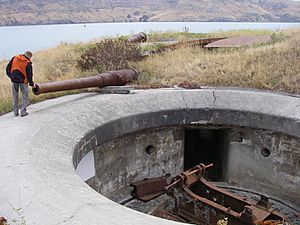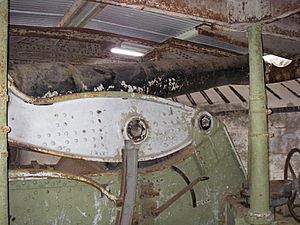Ripapa Island facts for kids
Ripapa Island, sometimes called Ripa Island, is a small island near Lyttelton Harbour (Whakaraupo) in New Zealand. It has played many important roles throughout New Zealand's history.
In the early 1800s, the island was a key place for the Ngāi Tahu tribe, a Māori group. Later, from 1873 to 1885, it was used as a quarantine station. This meant ships arriving from Britain to the nearby port of Lyttelton had to stop there first. This was to check if anyone on board was sick.
In 1880, some of the quarantine buildings were even used as a prison. Famous prisoners included Māori people from the Parihaka settlement in Taranaki. They were held there because they peacefully protested against the government taking and selling their land. The quarantine buildings were later taken down when the island became part of New Zealand's coastal defence system.
Contents
Ripapa Island: Early History
Ripapa Island was a perfect spot to build a pā. A pā is a fortified village built by Māori people. In the early 1800s, Chief Taununu of the Ngāi Tahu tribe built a pā on the island.
Around the 1820s, Chief Taununu faced a big conflict with another Ngāi Tahu group. This event is known as the Kai huanga feud. The Ngāi Tahu tribe lived on the island until about 1832.
Before this, Chief Te Whakarukeruke, who was living on Ripapa Island, left to help defend Kaiapoi. Kaiapoi was being attacked by Te Rauparaha. After Kaiapoi was defeated, Te Rauparaha took over several pā on and around Banks Peninsula. This included the pā on Ripapa Island. After this, Māori people did not live on the island again.
Fort Jervois: Protecting the Coast
Fort Jervois was built on Ripapa Island. It was one of four forts set up to protect Lyttelton Harbour. These forts were part of a bigger plan to defend New Zealand's coast. The fort was first built in 1886. It was made stronger because people worried about a possible attack from Russia. This event is known as the "Russian scare."
Fort Jervois is the most complete "Russian scare" fort still left in New Zealand. The New Zealand army used the fort from the time of the Russian scare until the end of World War I. It was also used again during World War II. During World War I, some prisoners of war were held at Fort Jervois. One famous prisoner was Felix von Luckner.
Special Guns at the Fort
Today, Fort Jervois is home to two very rare guns.
- One is a BL 8-inch gun. There are only about 12 of these left in the world. This gun can still work, but there are no shells left for it.
- The fort also has a smaller BL 6-inch gun. When this gun was first tested, its recoil system broke. The barrel cracked, and most of the gun was damaged. It had to be sent back to England for repairs. Another test in 1939 also cracked its mounting.
Even though these are the only two guns currently at Fort Jervois, there are places for two more guns. These two other guns are on the island, but they have been partly destroyed.
Caring for the Island
The Department of Conservation has been in charge of Ripapa Island since 1990. Heritage New Zealand has given Fort Jervois a special status as a Category I historic place. This means it is very important historically. The Department of Conservation in Canterbury actively looks after it. There are plans to make the island look like it did during World War II.
The June 2011 Christchurch earthquake caused damage to Fort Jervois. Because of this, the island was closed for some time. Repairs have now been finished, and the island reopened in November 2019. You can currently visit the island only by private boat. Public ferry services from Lyttelton wharf started again in 2020.
See also
 In Spanish: Isla Ripapa para niños
In Spanish: Isla Ripapa para niños





